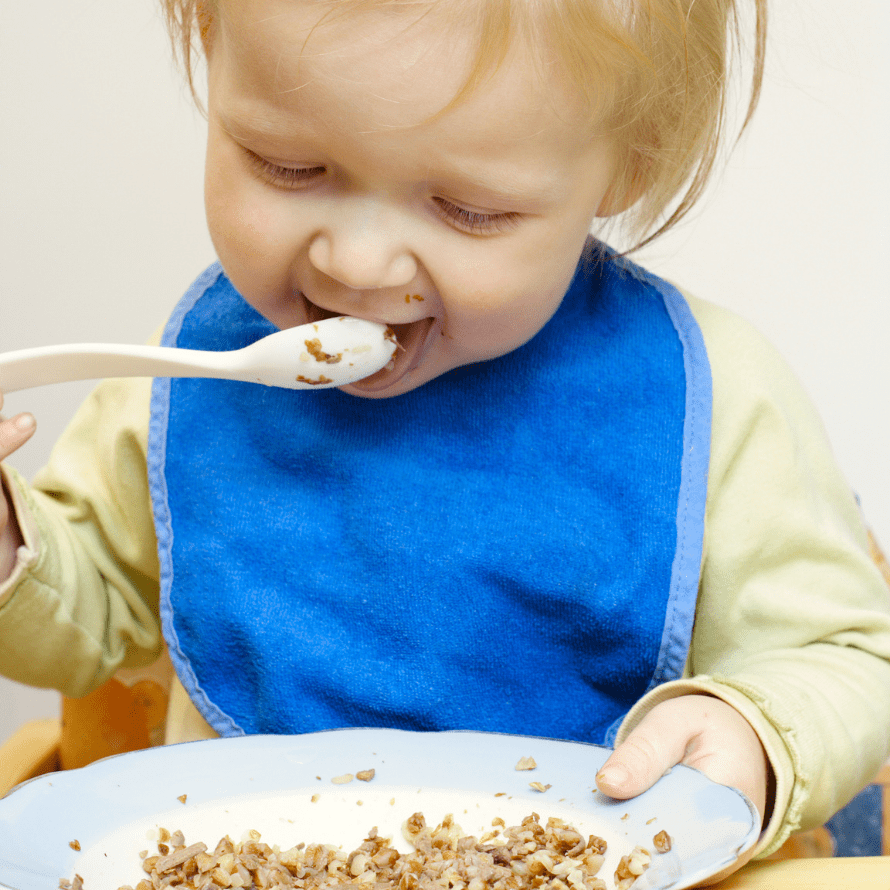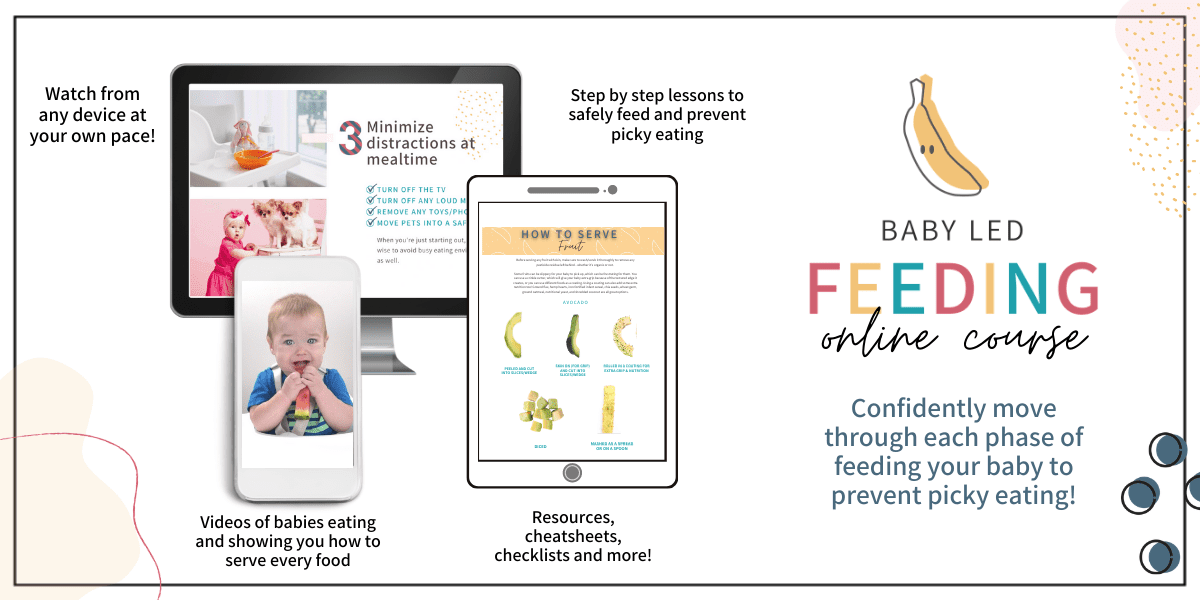
Can babies and toddlers digest starch? If you search for the answer to this question online, you’ll run into dire warnings of the dangers of giving starch to babies and kids under 2. People say that starch just “rots” in your baby’s gut and that they don’t have the enzymes they need to digest it. Serious warnings are given about this, completely shaming parents (in my opinion) for listening to “mainstream recommendations” that tell you to give your baby starchy foods as one of their first meals – because it causes food allergies and a host of other problems, or so they say…
Honestly, that’s a bit dramatic.
All this does is make you feel like if you’ve given your baby cereal, toast, or heck – even sweet potatoes- you’ve done something wrong.
This is a subject that you’ll see pop up in many-a-Facebook group, and on online blogs, and I’m here to get down to the real truth. I hate false fears in the nutrition world, let alone in the baby nutrition world, so let me clear this myth up right here and now.
If you’d like to listen to me debunk this myth, tune into the podcast episode here – you can even download it and save it for later!
What even is starch?
Starch is a type of complex carbohydrate made from lots of glucose molecules bonded together in long, branching chains. It’s a plant’s way of storing glucose – aka energy. Our brains use glucose directly, so we have to be able to break starch down into glucose in order to literally live and have energy. Starches are found, not just in grains, but in root vegetables, winter squashes, beans, and some fruits, like bananas. So this is not just an issue about grains!
How do we digest starch?
Here’s where the research comes in, and this is going to get a bit scientific, but let’s break it down. The digestion of starch actually begins in the mouth! There’s an enzyme called salivary amylase that starts to break down those large chains of glucose that form the starch, so that it’s partially digested. Then it makes its way down to the small intestine where pancreatic amylase – different from salivary amylase – is secreted by the pancreas and breaks it down even further (with the help of some other enzymes) until it’s only glucose molecules that can be absorbed directly.
The breakdown of starch in babies
Ok, so now let’s put it into the context of babies and their digestion, because it does differ slightly from adults. When babies are on an all breastmilk or formula diet, the type of carbohydrates they’re digesting are all simple sugars, primarily lactose. When they start solid foods, they’re adapting to starches for the first time. And to be clear, many cultures around the world do offer starch as one of the first foods, such as cereal or porridge.
And it’s interesting to think about this because if you look at the research around the digestive system of newborn babies, they actually don’t have any pancreatic amylase in the small intestine. Now, as the months go on, and they approach six months of age, they do start to develop more and more of it – and by 4-6 months of age, they do have some pancreatic amylase, but way less than the amount found in older kids and adults.
If I’m honest, what doesn’t make sense, at first, is how they seemed to be able to digest starch perfectly fine, without much pancreatic amylase! In this research, no issues occurred with digestion, nor were there really any negative symptoms at all. And to me, that part does make sense when I think about it. If we look at what babies are fed all around the world, generally those first foods are all starchy. In Tanzania they serve millet flour at 3 months; corn porridge at 3 months in Zimbabwe; beans and rice at 4 months in Brazil. And these are just a few examples. So how can it be that babies all around the world are able to digest starch, and have been able to for centuries, if they lack the enzymes to do so? Why did all these babies not have any issue digesting these foods, for generations?
Time for some more research. I found a small study that examined how much starch was found in a baby’s poop (which therefore indicates how much of it was digested), after various amounts were given to the babies, and at various ages. This study found that very little starch ended up in these babies’ diapers. When they were given between 1 tablespoon and ½ cup of starch per day, the babies appeared to digest more than 99% of it. The researchers then tried a larger dose, and actually gave several 1 month olds a full cup of rice starch. Three of these infants absorbed more than 99% of this amount. Two absorbed just 96%, with the other 4% ending up in their diapers, along with some diarrhea. In other words, within the first few months of life, babies can digest small amounts of starch just fine, but give them too much, and you’ll see some diarrhea. Obviously I’d never recommend giving 1 month old babies solids anyway, starch or no starch. And I’ve mentioned before that one of the MANY reasons why you should wait until 6 months of age, or so, to introduce solids is to ensure that their digestive system is ready. But it just goes to show that even at that young age, it’s still possible for babies to digest the majority of the starch that they ingest.
SO this still begs the question..how??? Well, there are a few theories that help explain why.
Reasons why babies CAN digest starch
- Babies make lots of salivary amylase which reaches near adult levels by 6 months of age. This enzyme survives the acidic conditions of the stomach reasonably well, and therefore even breaks down starch in the stomach after travelling there on the food from the mouth. So it basically works overtime to get the job done – first in the mouth and then in the stomach to continue the job there.
- Human breastmilk has lots of amylase! It’s actually present in the highest amount early on in colostrum, probably to make up for the fact that at this point babies only have very little salivary amylase and obviously no pancreatic amylase. And, breastmilk amylase continues to work in the small intestine in much the same way salivary amylase does – it survives acidic conditions in the stomach and works on breaking down the starch in the small intestine. What’s also so cool is that there are proteins in the breastmilk that protect breastmilk amylase, and one study showed the ability for only 100 ml of breastmilk to digest 20 g of starch in an hour! To put this into context, that’s about ⅔ cup of cereal, so clearly the breastmilk amylase works very efficiently, even without pancreatic amylase being present.
- Glucoamylase helps out in the small intestine too. This is another enzyme found in the small intestine, which also breaks down the glucose molecules in starch, and is actually extremely active in infants and present in high quantities for them as early as 1 month of age. So this clearly does the job for digesting starch when pancreatic amylase can’t. At this point it’s becoming clear that the digestion doesn’t operate in the same way as it does for adults, but it does still operate.
- A baby’s body produces more amylase as carbs are introduced. Interestingly, it seems that once complex carb-containing food is introduced to your baby, their body responds by secreting more amylase. The same thing occurs with protein introduction and trypsin, the enzyme that digests protein. This makes so much sense! Their body is going to respond based on what they’re eating – body’s are reactive and built to do exactly this.
- Starch fermentation in the large intestine promotes a healthy gut microbiome. Finally, critics have always said that a portion of starch doesn’t get digested in the small intestine, and therefore it sort of sits and “rots” there. But the truth is, this happens for adults too! And what the research actually shows is that instead of “rotting” in the small intestine, it moves into the large intestine and ferments. This process helps provide “food”, if you will, to the good bacteria in our gut, and therefore promotes a healthy gut microbiome. So for babies, there’s a significant amount of starch that does this in the large intestine. And this actually happens for an important reason. The beneficial bacteria it’s feeding when it ferments improves a baby’s ability to absorb nutrients, and is used as a source of energy when needed.
Even if they can handle starch, should we offer it?
I recommend including starch in your baby’s diet, and there are a few reasons I want to go over to explain why I recommend this, and why I think we actually need to be careful about limiting starch in a baby’s diet.
- Waiting too long to introduce grains to your baby could end up increasing the risk of developing celiac disease, Type 1 diabetes, and a wheat allergy. There seems to be a window of opportunity in mid-infancy – probably between about 5 to 7 months – where introduction to a variety of foods, including grains, starches, and gluten, decreases your baby’s risk of developing these chronic diseases, or wheat allergy, later on. This is basically the same concept I teach when it comes to introducing the top allergens early and often, which is based on the most updated recommendations. Doing this allows the body to respond to the proteins and create antibodies in order to handle those proteins and recognize them when they’re ingested. Therefore, decreasing the risk of a reaction, which is presumably the same idea as a baby’s ability to produce amylase in response to the introduction of starchy foods.
- Eliminating starch can make it more difficult for babies to get the nutrients they need. Let’s look at the obvious example, infant cereals. These are generally fortified with iron, which is one of the nutrients that is more likely to be deficient in infants. Now as you know, I also recommend offering other sources of iron to your baby, but using iron-fortified cereals is a really simple way to ensure your baby is getting the nutrients they need, and can definitely be part of a varied diet for your baby. I know lots of families do use them, so if we look at cutting those out because they contain starch, all of a sudden we’ve lost a really easy, convenient source of iron for your baby. In general, cutting out starches means cutting out a huge portion of your baby’s nutrition sources, meaning it will be more difficult for them to get the nutrients that they need, which can lead to more problems later on.
- Starch is found in so many foods, removing it from your baby’s diet takes away a lot of food options for them. This concern about starch digestion tends to be focused on avoiding grains, but remember that legumes and many fruits and vegetables also have lots of starch. So, if you truly tried to avoid starch, you would really be limiting your baby’s opportunities to get the nutrients they need (as mentioned above), and to experience different tastes and textures. Offering your baby a variety of foods is really important, and so that will always be my recommendation. Obviously in the case of allergies or intolerances, certain limitations will be necessary. But not including those circumstances, eating a variety of foods from all the food groups helps to ensure that your baby gets all the nutrients they need. And the exposure that your baby gets from being offered such a wide variety of foods is crucial in preventing picky eating too.
The bottom line is that it’s safe to feed babies starchy foods. They can digest them, and they are one part of a varied, balanced diet for babies that are ready to begin eating solid foods.
Interested in learning what foods are best to give your baby, how to serve them, how to prevent picky eating, and advance your baby onto finger foods without any fear or overwhelm? My Baby Led Feeding course is for you so you can confidently move through each phase of feeding to prevent picky eating!
References:
- Hadorn, B. et al. Quantitative assessment of exocrine pancreatic function in infants and children. J. Pediatr. 73, 39–50 (1968).
- Zoppi, G., Andreotti, G., Pajno-Ferrara, F., Njai, D. M. & Gaburro, D. Exocrine Pancreas Function in Premature and Full Term Neonates. Pediatr. Res. 6, 880–886 (1972).
- Fomon, S. J. Infant Feeding in the 20th Century: Formula and Beikost. J. Nutr. 131, 409S–420S (2001).
- Pelto, G. H., Levitt, E. & Thairu, L. Improving feeding practices: current patterns, common constraints, and the design of interventions. Food Nutr. Bull. 24, 45–82 (2003).
- De Vizia, B., Ciccimarra, F., De Cicco, N. & Auricchio, S. Digestibility of starches in infants and children. J. Pediatr. 86, 50–55 (1975).
- Rossiter, M. A., Barrowman, J. A., Dand, A. & Wharton, B. A. Amylase Content of Mixed Saliva in Children. Acta Pædiatrica 63, 389–392 (1974).
- Sevenhuysen, G. P., Holodinsky, C. & Dawes, C. Development of salivary alpha-amylase in infants from birth to 5 months. Am. J. Clin. Nutr. 39, 584–588 (1984).
- Murray, R. D. et al. The Contribution of Salivary Amylase to Glucose Polymer Hydrolysis in Premature Infants. Pediatr. Res. 20, 186–191 (1986).
- Rosenblum, J. L., Irwin, C. L. & Alpers, D. H. Starch and glucose oligosaccharides protect salivary-type amylase activity at acid pH. Am. J. Physiol. 254, G775–780 (1988).
- Shahani, K. M., Kwan, A. J. & Friend, B. A. Role and significance of enzymes in human milk. Am. J. Clin. Nutr. 33, 1861–1868 (1980).
- Jones, J. B., Mehta, N. R. & Hamosh, M. Alpha-Amylase in Preterm Human Milk. J. Pediatr. Gastroenterol. Nutr. 1, 43–48 (1982).
- Heitlinger, L. A., Lee, P. C., Dillon, W. P. & Lebenthal, E. Mammary Amylase: a Possible Alternate Pathway of Carbohydrate Digestion in Infancy. Pediatr. Res. 17, 15–18 (1983).
- Lindberg, T. & Skude, G. Amylase in human milk. Pediatrics 70, 235–238 (1982).
- Hegardt, P., Lindberg, T., Börjesson, J. & Skude, G. Amylase in human milk from mothers of preterm and term infants. J. Pediatr. Gastroenterol. Nutr. 3, 563–566 (1984).
- Lee, P. C., Werlin, S., Trost, B. & Struve, M. Glucoamylase activity in infants and children: normal values and relationship to symptoms and histological findings. J. Pediatr. Gastroenterol. Nutr. 39, 161–165 (2004).
- Lebenthal, E. & Lee, P. C. Glucoamylase and disaccharidase activities in normal subjects and in patients with mucosal injury of the small intestine. J. Pediatr. 97, 389–393 (1980).
- Shulman, R. J., Wong, W. W., Irving, C. S., Nichols, B. L. & Klein, P. D. Utilization of dietary cereal by young infants. J. Pediatr. 103, 23–28 (1983).
- Christian, M. T. et al. Modeling 13C Breath Curves to Determine Site and Extent of Starch Digestion and Fermentation in Infants. J. Pediatr. Gastroenterol. 34, 158–164 (2002).
- Stephen, A. et al. The role and requirements of digestible dietary carbohydrates in infants and toddlers. Eur. J. Clin. Nutr. 66, 765–779 (2012).
- Wong, J. M. W., de Souza, R., Kendall, C. W., Emam, A. & Jenkins, D. J. Colonic health: fermentation and short chain fatty acids. J. Clin. Gastroenterol. 40, 235–243 (2006).
- Christian, M. T. et al. Starch fermentation by faecal bacteria of infants, toddlers and adults: importance for energy salvage. Eur. J. Clin. Nutr. 57, 1486–1491 (2003).
- Scheiwiller, J., Arrigoni, E., Brouns, F. & Amadò, R. Human faecal microbiota develops the ability to degrade type 3 resistant starch during weaning. J. Pediatr. Gastroenterol. Nutr. 43, 584–591 (2006).
- Norris, J. M. et al. Risk of celiac disease autoimmunity and timing of gluten introduction in the diet of infants at increased risk of disease. J. Am. Med. Assoc. 293, 2343–2351 (2005).
- Norris, J. M. et al. Timing of initial cereal exposure in infancy and risk of islet autoimmunity. J. Am. Med. Assoc. 290, 1713–1720 (2003).
- Poole, J. A. et al. Timing of Initial Exposure to Cereal Grains and the Risk of Wheat Allergy. Pediatrics 117, 2175–2182 (2006).






